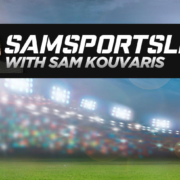Shaq attack!
For two years now, the NBA has been looking for a star. Somebody they can hang their hat on, somebody, anybody who will fill some of the void left by Michael Jordan’s departure. Look no further. Shaq has arrived.
It has been hard for Shaquille O’Neal to find his footing in the league. From heralded rookie, to villainous traitor to budding star in a star town, O’Neal has gone about life just about how most other guys in their 20’s do: Grabbing everything and seeing what fits.
Coming out of LSU two years early, O’Neal was considered raw. Not polished enough for the NBA game. Turns out Shaq the athlete just needed to catch up with Shaq the basketball player. A player of enormous size isn’t supposed to have a soft touch, or quick feet, or good speed. O’Neal had it all, it just wasn’t in a package as a basketball player yet. In Orlando, they found out he could dominate games, and with a decent supporting cast, took the Magic to the NBA finals. He was young, the team was young and they were blasted out. Quickly.
Perhaps that exposure to the bright lights in the NBA finals gave O’Neal a taste of what he could be. Not only as a basketball player, but as a star. As a rapper, Shaq made a name for himself in the music world. As an actor, he showed a showmanship that spilled over onto the court. Hollywood was at his doorstep, and the Lakers were only too happy to oblige. Remember, at the time, Shaq was considered another good, big center. Somebody with amazing potential, but without much to show for it. Jerry West knew he’d be a good fit with the bright lights of LA and the Lakers shelled out the money to get him. The move cast O’Neal as a villain in most places besides Orlando. He just went for the money, they said. He’d be a good player if he’d leave that other stupid stuff alone and concentrate on the game, they added. Shaq doesn’t like the villain role. He likes being the good guy. The guy in the white hat. He didn’t like the things being said about him, and it affected his game.
Over the last two years, a new Shaq has emerged. Continually playful, self-effacing and immensely proud, O’Neal needed guidance on how to become a champion. Phil Jackson provided the vehicle to take the next step. He still wrapped his head in a towel like a turban for post-game interviews and had that goofy smile, but worked intensely on his game. Shaq still comes up with silly nicknames for himself, but Washington Post columnist Michael Wilbon claims he shagged free-throws for O’Neal for two straight hours one day in a high school gym. What other big star pro athlete calls up a TV reporter in Orlando and says “Come on over, let’s go water skiing?” Do any other guys at that level say their name as a wrestler would be “Big Foot Tornado?”
I’ve talked with Shaq a few times, and unlike a lot of other pro athletes, he’s cordial, polite and funny. I asked him after a Magic game one night if he wanted to do an interview right then or after he showered. O’Neal stood up, patted me on the chest and said, “I’ll be right back.” His hand covered me from shoulder to shoulder and he was and is the largest person I’ve ever seen. He returned, and answered questions until everybody was done.
The NBA need look no further for their national superstar. Shaquille O’Neal isn’t going to get in any trouble. He’s not going to choke a coach, or turn up as the father of 7 children by 6 different mothers. He’s got an engaging personality, a self-effacing manner and a strong enough sense of self to make fun of himself in those “Baby Bob” commercials. Go ahead and give him the national endorsement contracts. Let him make all the “I love this game” commercials. The league needs a star. He’s currently shining in Los Angeles.


